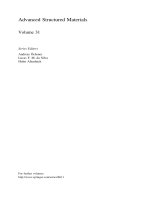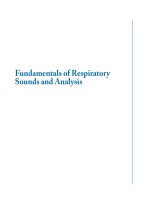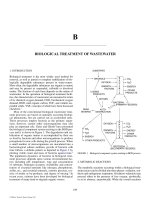Fundamentals of Environmental Sampling and Analysis doc
Bạn đang xem bản rút gọn của tài liệu. Xem và tải ngay bản đầy đủ của tài liệu tại đây (4.67 MB, 457 trang )
Fundamentals
of Environmental
Sampling and AnalysisFundamentals
of Environmental
Sampling and Analysis
Chunlong (Carl) Zhang
University of Houston-Clear Lake
WILEY-INTERSCIENCE
A John Wiley & Sons, Inc., Publication
Copyright ß 2007 by John Wiley & Sons, Inc. All rights reserved
Published by John Wiley & Sons, Inc., Hoboken, New Jersey
Published simultaneously in Canada
No part of this publication may be reproduced, stored in a retrieval system, or transmitted in any
form or by any means, electronic, mechanical, photocopying, recording, scanning, or otherwise, except
as permitted under Section 107 or 108 of the 1976 United States Copyright Act, without either the
prior written permission of the Publisher, or authorization through payment of the appropriate per-copy
fee to the Copyright Clearance Center, Inc., 222 Rosewood Drive, Danvers, MA 01923, (978) 750-8400,
fax (978) 750-4470, or on the web at www.copyright.com. Requests to the Publisher for permission
should be addressed to the Permissions Department, John Wiley & Sons, Inc., 111 River Street, Hoboken,
NJ 07030, (201) 748-6011, fax (201) 748-6008, or online at />Limit of Liability/Disclaimer of Warranty: While the publisher and author have used their best efforts
in preparing this book, they make no representations or warranties with respect to the accuracy or
completeness of the contents of this book and specifically disclaim any implied warranties of
merchantability or fitness for a particular purpose. No warranty may be created or extended by sales
representatives or written sales materials. The advice and strategies contained herein may not be
suitable for your situation. You should consult with a professional where appropriate. Neither the
publisher nor author shall be liable for any loss of profit or any other commercial damages, including
but not limited to special, incidental, consequential, or other damages.
For general information on our other products and services or for technical support, please contact
our Customer Care Department within the United States at (800) 762-2974, outside the United States
at (317) 572-3993 or fax (317) 572-4002.
Wiley also publishes its books in a variety of electronic formats. Some content that appears in print
may not be available in electronic formats. For more information about Wiley products, visit our
web site at www.wiley.com.
Wiley Bicentennial Logo: Richard J. Pacifico
Library of Congress Cataloging-in-Publication Data:
Fundamentals of environmental sampling and analysis / Chunlong Carl Zhang.
p. cm.
ISBN: 978-0-471-71097-4
1. Environmental sampling. 2. Environmental sciences–Statistical methods. I. Title.
GE45.S75Z43 2007
628–dc22 2006030899
Printed in the United States of America
10987654321
To
My Parents
To My Wife Sue and
Two Sons
Richard and Arnold
Contents
Preface xvii
1. Introduction to Environmental Dat a Acquisition 1
1.1 Introduction 1
1.1.1 Importance of Scientifically Reliable and Legally
Defensible Data
2
1.1.2 Sampling Error vs. Analytical Error During
Data Acquisition
4
1.2 Environmental Sampling 5
1.2.1 Scope of Environmental Sa mpling 5
1.2.2 Where, When, What, How, and How Many 6
1.3 Environmental Analysis 6
1.3.1 Uniqueness of Modern Environmental Analysis 7
1.3.2 Classical and Modern Analytical and Monitoring Techniques
7
References 9
Questions and Problems 10
2. Basics of Environmental Sampling and Analysis 11
2.1 Essential Analytical and Organic Chemistry 11
2.1.1 Concentration Units 11
2.1.2 Common Organic Pollutants and Their Properties 14
2.1.3 Analytical Precision, Accuracy, and Recovery 16
2.1.4 Detection Limit and Quantitation Limit 17
2.1.5 Standard Calibration Curve 18
2.2 Essential Environmental Statistics 20
2.2.1 Measurements of Central Tendency and Dispersion 20
2.2.2 Understanding Probability Distributions 21
2.2.3 Type I and II Errors: False Positive and False Negative 25
vii
2.2.4 Detection of Outliers 26
2.2.5 Analysis of Censored Data 28
2.2.6 Analysis of Spatial and Time Series Data 29
2.3 Essential Hydrology and Geology 30
2.3.1 Stream Water Flow and Measurement 30
2.3.2 Groundwater Flow in Aquifers 31
2.3.3 Groundwater Wells 32
2.4 Essential Knowledge of Environmental Regulations 35
2.4.1 Major Regulations Administrated by the U.S. EPA 35
2.4.2 Other Important Environmental Regulations
35
References 37
Questions and Problems 39
3. Environmental Sampling Design 45
3.1 Planning and Sampling Protocols 45
3.1.1 Data Quality Objectives 46
3.1.2 Basic Considerations of Sampling Plan 48
3.2 Sampling Environmental Population 49
3.2.1 Where (Space) and When (Time) to Sample 49
3.2.2 Obtain Representative Samples from Various Matrices 49
3.3 Environmental Sampling Approaches: Where and When 52
3.3.1 Judgmental Sampling 52
3.3.2 Simple Random Sampling 53
3.3.3 Stratified Random Sampling 54
3.3.4 Systematic Sampling 56
3.3.5 Other Sampling Designs 57
3.4 Estimating Sample Numbers: How Many Samples are Required 61
References 63
Questions and Problems 63
4. Environmental Sampling Techniques 69
4.1 General Guidelines of Environmental Sampling Techniques 69
4.1.1 Sequence of Sampling Matrices and Analytes 70
viii Contents
4.1.2 Sample Amount 70
4.1.3 Sample Preservation and Storage 71
4.1.4 Selection of Sample Containers 74
4.1.5 Selection of Sampling Equipment 76
4.2 Techniques for Sampling Various Media:
Practical Approaches and Tips
83
4.2.1 Surface Water and Wastewater Sampling 84
4.2.2 Groundwater Sampling 86
4.2.3 Soil and Sediment Sampling 89
4.2.4 Hazardous Waste Sampling 90
4.2.5 Biological Sampling
92
4.2.6 Air and Stack Emission Sampling 92
References 93
Questions and Problems 94
5. Methodology and Quality Assurance/Quality Control
of Environmental Analysis
97
5.1 Overview on Standard Methodologies 98
5.1.1 The U.S. EPA Methods for Air, Water, Wastewater,
and Hazardous Waste
98
5.1.2 Other Applicable Methods:
APHA/ASTM/OSHA/NIOSH/USGS/AOAC
103
5.2 Selection of Standard Methods 108
5.2.1 Methods for Sample Preparation 109
5.2.2 Methods for Physical, Biological, and General
Chemical Parameters
111
5.2.3 Methods for Volatile Organic Compounds (VOCs) 112
5.2.4 Methods for Semivolatile Organic Compounds (SVOCs) 113
5.2.5 Methods for Other Pollutants and Compounds
of Emerging Environmental Concerns
113
5.3 Field Quality Assurance/Quality Control (QA/QC) 115
5.3.1 Types of Field QA/QC Samples 116
5.3.2 Numbers of Field QA/QC Samples 118
5.4 Analytical Quality Assurance/Quality Control 118
5.4.1 Quality Control Procedures for Sample Preparation 118
5.4.2 Quality Control Procedures During Analysis 119
Contents
ix
References 122
Questions and Problems 123
6. Common Operations and Wet Chemical Methods
in Environmental Laboratories
127
6.1 Basic Operations in Env ironmental Laboratories 128
6.1.1 Labware Cleaning Protocols for Trace Analysis 128
6.1.2 Chemical Reagent Purity, Standard, and Reference Materials 129
6.1.3 Volumetric Glassware and Calibration 132
6.1.4 Laboratory Health, Safety, and Emergency First Aid 134
6.1.5 Waste Handling and Disposal 136
6.2 Wet Chemical Methods and Common Techniques
in Environmental Analysis
137
6.2.1 Gravimetric and Volumetric Wet Chemical Methods 137
6.2.2 Common Laboratory Techniques 138
6.3 Analytical Principles for Common Wet Chemical Methods 141
6.3.1 Moisture in Solid and Biological Samples 141
6.3.2 Solids in Water, Wastewater,
and Sludge (TS, TSS, TDS, VS)
141
6.3.3 Acidity, Alkalinity, and Hardness of Waters 142
6.3.4 Oxygen Demand in Water and Wastewater
(DO, BOD and COD)
145
6.3.5 Oil and Grease in Water and Wastewater 148
6.3.6 Residual Chlorine and Chloride in Drinking Water 149
6.3.7 Ammonia in Wastewater 152
6.3.8 Cyanide in Water, Wastewater and Soil Extract 153
6.3.9 Sulfide in Water and Waste 154
References 155
Questions and Problems 155
7. Fundamentals of Sample Preparation for
Environmental Analysis
159
7.1 Overview on Sample Preparation 160
7.1.1 Purpose of Sample Preparation 160
7.1.2 Types of Sample Preparation 161
x Contents
7.2 Sample Preparation for Metal Analysis 162
7.2.1 Various Forms of Metals and Preparation Methods 162
7.2.2 Principles of Acid Digestion and Selection of Acid 163
7.2.3 Alkaline Digestion and Other Extraction Methods 165
7.3 Extraction for SVOC and Non-VOC from Liquid or
Solid Samples
168
7.3.1 Separatory Funnel and Continuous Liquid–Liquid
Extraction (LLE)
168
7.3.2 Solid Phase Extraction 171
7.3.3 Solid Phase Microextraction 173
7.3.4 Soxhlet and Automatic Soxhlet Extraction (Soxtec)
174
7.3.5 Ultrasonic Extraction 176
7.3.6 Pressured Fluid Extraction 177
7.3.7 Supercritical Fluid Extraction 177
7.3.8 Comparison and Selection of Organic Extraction Methods 178
7.4 Post-Extraction Clean-up of Organic Compounds 179
7.4.1 Theories and Operation Principles of Various
Clean-up Methods
179
7.4.2 Recommended Clean-up Method for Selected
Compounds
181
7.5 Derivatization of Non-VOC for Gas Phase Analysis 182
7.6 Sample Preparation for VOC, Air and Stack Gas Emission 183
7.6.1 Dynamic Headspace Extraction (Purge-and-Trap) 183
7.6.2 Static Headspace Extraction 184
7.6.3 Azeotropic and Vacuum Distillation 185
7.6.4 Volatile Organic Sampling Train 186
References 187
Questions and Problems 187
8. UV-Visible and Infrared Spectroscopic Methods in
Environmental Analysis
190
8.1 Introduction to the Principles of Spectroscopy 191
8.1.1 Understanding the Interactions of Various Radiations
with Matter
191
8.1.2 Origins of Absorption in Relation to Molecular
Orbital Theories
193
Contents
xi
8.1.3 Molecular Structure and UV-Visible/Infrared Spectra 200
8.1.4 Quantitative Analysis with Beer-Lambert’s Law 204
8.2 UV-Visible Spectroscopy 206
8.2.1 UV-Visible Instrumentation 206
8.2.2 UV-VIS as a Workhorse in Environmental Analysis 208
8.3 Infrared Spectroscopy 211
8.3.1 Fourier Transform Infrared Spectrometers (FTIR) 211
8.3.2 Dispersive Infrared Instruments (DIR) 213
8.3.3 Nondispersive Infrared Instruments (NDIR ) 214
8.3.4 Applications in Industrial Hygiene and Air Pollution
Monitoring
214
8.4 Practical Aspects of UV-Visible and Infrared Spectrometry 215
8.4.1 Common Tips for UV-Visible Spectroscopic Analysis 215
8.4.2 Sample Preparation for Infrared Spectroscopic Analysis 216
References 217
Questions and Problems 218
9. Atomic Spectroscopy for Metal Analysis 220
9.1 Introduction to the Principles of Atomic Spectroscopy 221
9.1.1 Flame and Flameless Atomic Absorption 221
9.1.2 Inductively Coupled Plasma Atomic Emission 225
9.1.3 Atomic X-ray Fluorescence 227
9.2 Instruments for Atomic Spectroscopy 227
9.2.1 Flame and Flameless Atomic Absorption 227
9.2.2 Cold Vapor and Hydride Generation Atomic Absorption
229
9.2.3 Inductively Coupled Plasma Atomic Emission 232
9.2.4 Atomic X-ray Fluorescence 233
9.3 Selection of the Proper Atomic Spectroscopic Techniques 235
9.3.1 Comparison of Detection Limits and Working Range 235
9.3.2 Comparison of Interferences and Other Considerations 236
9.4 Practical Tips to Sampling, Sample Preparation,
and Metal Analysis
240
References 243
Questions and Problems 243
xii Contents
10. Chromatographic Methods for Environmental Analysis 246
10.1 Introduction to Chromatography 247
10.1.1 Types of Chromatography and Separation Columns 247
10.1.2 Common Stationary Phases: The Key to Separation 249
10.1.3 Other Parameters Important to Compound Separation 251
10.1.4 Terms and Theories of Chromatogram 254
10.1.5 Use of Chromatograms for Qualitative
and Quantitative Analysis
258
10.2 Instruments of Chromatographic Methods 258
10.2.1 Gas Chromatography 258
10.2.2 High Performance Liquid Chromatography (HPLC) 260
10.2.3 Ion Chromatography 264
10.2.4 Supercritical Fluid Chromatography 265
10.3 Common Detectors for Chromatography 266
10.3.1 Detectors for Gas Chromatography 267
10.3.2 Detectors for High Performance Liquid
Chromatography
272
10.3.3 Detectors for Ion Chromatography 274
10.4 Applications of Chromatographic Methods
in Environmental Ana lysis
275
10.4.1 Gases, Volatile, and Semivolatile Organics with GC 276
10.4.2 Semivolatile and Nonvolatile Organics with HPLC
278
10.4.3 Ionic Species with IC 278
10.5 Practical Tips to Chromatographic Methods 279
10.5.1 What Can and Cannot be Done with GC and HPLC 279
10.5.2 Development for GC and HPLC Methods 280
10.5.3 Overview on Maintenance and Troubleshooting 281
References 284
Questions and Problems 285
11. Electrochemical Methods for Environmental Analysis 289
11.1 Introduction to Electrochemical Theories 290
11.1.1 Review of Redox Chemistry and Electrochemical Cells 290
11.1.2 General Principles of Electroanalytical Methods 292
11.1.3 Types of Electrodes and Notations
for Electrochemical Cells 295
Contents
xiii
11.2 Potentiometric Applications in Environmental Analysis 296
11.2.1 Measurement of pH 296
11.2.2 Measurement of Ions by Ion Selective Electrodes (ISEs) 298
11.2.3 Potentiometric Titration (Indirect Potentiometry) 299
11.3 Voltammetric Applications in Environmental Analysis 300
11.3.1 Measurement of Dissolved Oxygen 300
11.3.2 Measurement of Anions by Amperometric Titration 302
11.3.3 Measurement of Metals by Anodic Stripping
Voltammetry (ASV)
303
References 305
Questions and Problems 306
12. Other Instrumental Methods in Environmental Analysis 309
12.1 Hyphenated Mass Spectrometric Methods and Applications 310
12.1.1 Atomic Mass Spectrometry (ICP-MS) 310
12.1.2 Molecular Mass Spectrometry (GC-MS and LC-MS) 313
12.1.3 Mass Spectrometric Applications
in Environmental Ana lysis
320
12.2 Nuclear Magnetic Resonance Spectroscopy (NMR) 322
12.2.1 NMR Spectrometers and the Origin of NMR Signals 322
12.2.2 Molecular Structures and NMR Spectra
325
12.2.3 Applications of NMR in Environmental Analysis 329
12.3 Miscellaneous Methods 329
12.3.1 Radiochemical Analysis 329
12.3.2 Surface and Interface Analysis 333
12.3.3 Screening Methods Using Immunoassay 334
References 335
Questions and Problems 336
Experiments 339
Experiment 1. Data Analysis and Statistical Treatment: A Case
Study on Ozone Concentrations in Cities of
Houston-Galveston Area
340
xiv Contents
Experiment 2. Collection and Preservation of Surface Water and Sediment
Samples and Field Measurement of Several
Water Quality Parameters
344
Experiment 3. Gravimetric Analysis of Solids and Titrimetric
Measurement of Alkalinity of Streams
and Lakes
348
Experiment 4. Determination of Dissolved Oxygen (DO) by Titrimetric
Winkler Method
352
Experiment 5. Determination of Chemical Oxygen Demand (COD) in
Water and Wastewater
357
Experiment 6. Determination of Nitrate and Nitrite in Water by
UV-Visible Spectrometry
362
Experiment 7. Determination of Anionic Surfactant (Detergent) by
Liquid-Liquid Extraction Followed by
Colorimetric Methods
366
Experiment 8. Determination of Hexavalent and Trivalent Chromium
(Cr
6þ
and Cr
3þ
) in Water by Visible Spectrometry 370
Experiment 9. Determination of Greenhouse Gases by Fourier Transform
Infrared Spectrometer
374
Experiment 10. Determination of Metals in Soil–Acid Digestion
and Inductively Coupled Plasma–Optical Emission
Spectroscopy (ICP-OES)
378
Experiment 11. Determination of Explosives Compounds in a
Contaminated Soil by High Performance Liquid
Chromatography (HPLC)
382
Experiment 12. Measurement of Headspace Chloroethylene by Gas
Chromatography with Flame Ionization
Detector (GC-FID)
386
Experiment 13. Determination of Chloroethylene by Gas Chromatography
with Electron Capture Detector (GC-ECD)
390
Experiment 14. Use of Ion Selective Electrode to Determine
Trace Level of Fluoride in Drinking
and Natural Water
392
Experiment 15. Identification of BTEX and Chlorobenzene Compounds
by Gas Chromatography-Mass Spectrometry
(GC–MS)
396
Contents
xv
Appendices 402
A. Common Abbreviations and Acronyms
402
B. Structures and Properties of Important Organic Polluta nts 407
C1. Standard Normal Cumulative Probabilities 417
C2. Percentiles of t-Distribution 418
C3. Critical Values for the F-Distribution 419
D. Required Containers, Preservation Techniques, and Holding Times 420
Index 423
xvi
Contents
Preface
The acquisition of reliable and defensible environmental data through proper
sampling and analytical technique is often an essential part of the careers for many
environmental professionals. However, there is currently a very diverse and diffuse
source of literature in the field of environmental sampling and analysis. The nature
of the literature often makes beginners and even skilled environmental professionals
find it very difficult to comprehend the needed contents. The overall objective of this
text is to introduce a comprehensive overview on the fundamentals of environmental
sampling and analysis for students in environmenta l science and engineering as well
as environmental professio nals who are involved in various stages of sampling and
analytical work.
Two unique features are evident in this book. First, this book presents a ‘‘know
why’’ rather than a ‘‘know how’’ strategy. It is not intended to be a cookbook that
presents the step-by-step details. Rather, fundamentals of sampling, selection of
standard methods, chemical and instrumental principles, and method applications to
particular contaminants are detailed. Second, the book gives an integrated
introduction to sampling and analysi s—both are essential to quality environmental
data. For example, contrary to other books that introduce a specific area of sampling
and analysis, this text provides a balanced mix of field sampling and laboratory
analysis, essential knowledge in chemistry, statistics, hydrology, wet chemical
methods for conventional chemicals, as well as various modern instru mental
techniques for contaminants of emerging concerns.
Chapter 1 starts with an overview on the framework of environmental sampling
and analysis and the importance for the acquisition of scientifically reliable and
legally defensible data. Chapter 2 provides some background information necessary
for the readers to better understand the subsequent chapters, such as review on
analytical and organic chemistry, statistics for data analysis, hydrogeology, and
environmental regulations relevant to sampling and analysis. The following two
chapters introduce the fundamentals of environmental sampling—where and when
to take samples, how many, how much, and how to take samples from air, liquid, and
solid media.
Chapter 5 introduces the standard methodologies by the US EPA and other
agencies. Their structures, method classifications, and cross references among
various standards are presented to aid readers in selecting the proper methods.
Quality assurance and quality control (QA/QC) for both sampling and analysis are
also included in this chapter as a part of the standard methodology. Chapter 6
provides some typical operations in environmental laboratories and details the
chemical principles of wet chemical methods most commonly used in environmental
xvii
analysis. Prior to the introduction to instrumental analysis and applications in
environmental analysis in Chapters 8–12, various sample preparation methods are
discussed and compared in Chapter 7.
In Chapter 8, the theories of absorption spectroscopy for qualitative and
quantitative analysis are presented. UV-visible spectroscopy is the main focus of this
chapter because nowadays it is still the workhorse in many of the environmental
laboratories. Chapter 9 is devoted to metal analysis using various atomic absorption
and emission spectrometric methods. Chapter 10 focuses on the instrumental
principles of the three most important chromatographic methods in environmental
analysis, i.e., gas chromatography (GC), high performance liquid chromatography
(HPLC), and ion chromatography (IC). Cha pter 11 introduces the electrochemical
principles and instrumentations for some common environmental analysis, such as
pH, potential titrations, dissolved oxygen, ion selective electrodes, conductivity, and
metal analysis using anodic stripping voltammetry. Chapter 12 introduces several
analytical techniques that are becoming increasingly important to meet today’s
challenge in environmental analysis, such as various hyphenated mass spectro-
metries using ICP/MS, GS/MS and LC/MS. This last chapter concludes with a brief
introduction to nuclear magnetic resonance spectroscopy (less commonly used in
quantitative analysis but important to structural identifications in environmental
research) and specific instrumentations including radiochemical analysis, electron
scanning microscopes, and immunoassays.
The selections of the above topics are based on my own teaching and practical
experience and the philosophy that sampling and analysis are equally important as
both are an integral part of reliable data. An understanding of the principles of
sampling, chemical analysis, and instrumentation is more important than knowing
‘‘specific how.’’ It is not uncommon to witness how time and resources are wasted by
many beginners in sampling and analysis. This occurs when samplers and analysts
used improper sampling and analytical protocols. This occurs also when proper
procedures from ‘‘step-by-step’’ cookbook were followed, but the samplers or
analysts did not make proper modifications without understanding the fundamentals.
Even skilled professionals are not immune to errors or unnecessary expenses during
sampling, sample preparation and analytical processes if underlying fundamentals
are either neglected or misinterpreted.
WHOM THIS BOOK IS WRITTEN FOR
This book is primarily targeted to beginners, such as students in environmental
science and engineering as well as environmental professionals who are directly
involved in sampling and analytical work or indirectly use and interpret
environmental data for various purposes. It is, therefore, written as a textbook for
senior undergraduates and graduate students as well as a reference book for general
audiences.
Several approaches are used to enhance the book for such a wide usage. (1)
Theories and principles will be introduced first in place of specific protocols
xviii
Preface
followed by examples to promote logical thinking by orienting these principles to
specific project applications. Questions and exercise problems are included in each
chapter to help to understand these concepts. (2) Suggested readings are given at the
end of each chapter for those who need further information or specific details from
standard handbooks (EPA, ASTM, OSHA, etc.) or journal articles. This list of
references is intended to provide an up-to-date single source information describing
the details that readers will find for their particular needs. (3) Practical tips are given
in most chapters for those who want to advance in this field. (4) A total of 15
experiments covering data analysis, sampling, sample preparation, and chemical/
instrumental analysis are provided for use as a supplemental lab manual.
TO THE INSTRUCTOR
This 12-chapter book contains chapters of sampling (Chapters 2–4), standard
methods and QA/QC (Chapter 5), wet analysis (Chapter 6), sample preparation
(Chapter 7), and instrumental analysis (Chapters 8–12). It is designed to have more
materials than needed for a one-semester course. Depending on your course focus
(e.g., sampling vs. analysis) and the level of students, you can select topics most
relevant to your course. These 12-chapters are better served in a lecture course but it
can be used as a supplemental textbook for a lab-based course. Even though some
chapter may not be covered in details for your particular course, the book can
certainly be used as a valuable reference.
EXPERIMENTS
There are 15 experiments included in the book covering various sampling and
analysis techniques, such as computer-based data analysis, field sampling, labo-
ratory wet chemical techniques, and instrumental analysis. These 15 experiments
alone should be suited to an instruction manual for a lab-based course. Several exp-
eriments require more advanced instruments such as IR, HPLC, GC, and GC-MS.
If such resources are limited, the Instructor can select proper labs from the list,
which can be based entirely on gravimetric, volumetric, and UV-vi sible spectro-
scopic analysis using analytical balance, burette, visible spectrometer, and pH
meters. Each experiment can be completed during a 2–3 h lab session. Many of these
lab procedures have been tested in author’s lab with various TAs during the last
several years. They have been debugged and are shown to be workable.
ACKNOWLEDGMENTS
Materials of this book have been used in several lecture and lab-based courses at the
University of Houston. I first would like to thank my students for their comments,
suggestions, and encouragement. These feedbacks are typically not technically
detailed, but help me immeasurably to improve its readability. Certainly I would like
Preface xix
to thank several technical reviewers (including several anonymous) from the review
of the book proposal at the beginning to the review of the final draft. Thanks are due
to Professors Todd Anderson (Texas Tech University), Joceline Boucher (Main
Maritime Academy), and Kalliat Valsaraj (Louisiana State University). I have also
invited several individuals to proofread all chapters in their expert areas, including
Dr. Dennis Casserly (Associate Professor, University of Houston – Clear Lake),
Dr. Dean Muirhead (Senior Project Engineer, NASA-JSC), Dr. Xiaodong Song
(Principle Scientist, Pfizer Corporation), Mr. Jay Gandhi (Senior Development
Chemist, Metrohm – Peak Inc.), and my thanks to them all.
Special thanks to Wiley’s Executive Editor Bob Esposito for his vision of this
project. Senior Editorial Assistant Jonathan Rose has been extremely helpful in
insuring me the right format of this writ ing even from the beginning of this project.
My sincere thanks to several other members of Wiley’s editorial and production
team, including Brendan Sullivan, Danielle Lacourciere, and Ekta Handa. It has
been a pleasant experience in working with this editorial team of high professional
standards and experience.
This book would not be accomplished without the support and love of my wife
Sue and the joys I have shared with my two sons, Richard and Arnold. Even during
many hours of my absence in the past two years for this project, I felt the drive and
inspiration. This book is written as a return for their love and devotion. With that, I
felt at some points the obligation of fulfilling and delivering what is beyond my
capability.
ABOUT THE AUTHOR
Dr. Zhang is currently an associate professor in environmental science and
environmental chemistry at the University of Houston-Clear Lake. He lectures
extensively in the area of environmental sampling and analysis. With over two
decades of vari ous experience in academia, industries, and consulting, his expertise
in environmental sampling and analysis covers a variety of first-hand practical
experience both in the field and in the lab. His field and analytical work has included
multimedia sampling (air, water, soil, sediment, plant, and waste materials) and
analysis of various environmental chemicals with an array of classical chemical
methods as well as modern instrumental techniques.
The author will be happy to receive comments and suggestions about this book
at his e-mail address:
C
HUNLONG (CARL)ZHANG
Houston, Texas
August 2006
xx Preface
Chapter 1
Introduction to Environmental
Data Acquisition
1.1 INTRODUCTION
1.2 ENVIRONMENTAL SAMPLING
1.3 ENVIRONMENTAL ANALYSIS
REFERENCES
QUESTIONS AND PROBLEMS
This introductory chapter will give readers a brief overview of the purposes and
scopes of environmental sampling and analysis. Sampling and analysis, apparent ly
the independent steps during data acquisition, are in fact the integrated parts to
obtain quality data—the type of data that are expected to sustain scientific and legal
challenges. The importance of environmental sampling and the uniqueness of
environmental analysis as opposed to traditional analytical chemistry are discussed.
A brief history of classical to modern instrumental analysis is also introduced in this
chapter.
1.1 INTRODUCTION
The objectives of environmental sampling and analysis may vary depending on the
specific project (task), including regulatory enforcement, regulatory compliance,
routine monitoring, emergency response, and scientific research. The examples are
as follows:
1. To determine how much pollutant enters into environment through stack
emission, wastewater discharge, and so forth in order to comply with a
regulatory requirement.
Fundamentals of Environmental Sampling and Analysis, by Chunlong Zhang
Copyright # 2007 John Wiley & Sons, Inc.
1
2. To measure ambient background concentration and assess the degree of
pollution and to identify the short- and long-term trends.
3. To detect accidental releases and evaluate the risk and toxicity to human and
biota.
4. To study the fate and transport of contaminants and evaluate the efficiency
of remediation systems.
This introductory chapter briefly discusses the basic process of environmental data
acquisition and erro rs associated with field sampling and laboratory analysis. A
unique feature of this text is to treat sampling and analysis as an entity. This is to say
that sampling and analysis are closely related and dependent on each other. The data
quality depends on the good work of both sampler and analyst.
The importance of sampling is obvious. If a sample is not collected properly, if it
does not represent the system we are trying to analyze, then all our careful lab work
is useless! A bad sampler will by no means generate good reliable data. In some
cases, even if sampling protocols are properly followed, the design of sampling is
critical, particularly when the analytical work is so costly.
Then what will be the data quality after a right sample is submitted for a lab
analysis? The results now depend on the chemist who further perform s the lab
analysis. The importance of sample analysis is also evident. If the analyst is unable
to define an inherent level of analytical error (precision, accuracy, recovery, and so
forth), such data are also useless. The analyst must also know the complex nature of
a sample matrix for better results. The analyst needs to communicate well with the
field sampler for proper sample preservation and storage protocols.
1.1.1 Importance of Scientifically Reliable
and Legally Defensible Data
All environmental data should be scientifically reliable. Scientific reliability means
that proper procedures for sampling and analysis are followed so that the results
accurately reflect the content of the sample. If the result does not reflect the sample,
there is no claim of validity. Scientifically defective data may be a result of
unintentional or deliberate efforts. The examples include the following:
An incorrect sampling protocol (bad sampler)
An incorrect analytical protocol (bad analyst)
The lack of a good laboratory practice (GLP)
The falsification of test results.
Good laboratory practice (GLP) is a quality system concerned with the
organizational process and the conditions under which studies are planned,
performed, monitored, recorded, archived, and reported. The term ‘‘defensible’’
means ‘‘the ability to withstand any reasonable challenge related to the veracity,
integrity, or quality of the logical, technical, or scientific approach taken in a
2
Chapter 1 Introduction to Environmental Data Acquisition
decision-making process.’’ As scientific reliability must be established for all
environmental data, legal defensibility may not be needed in all cases such as the one
in most academic research projects. Legal defensibility is critical in many other
circumstances such as in most of the industrial and governmental settings.
Components of legally defensible data include, but are not limited to:
Custody or Control
Documentation
Traceability.
Custody or Control: To be defensible in court, sample integrity must be maintained
to remove any doubts of sample tampering/alteration. A chain-of-custody form
can be used to prove evidence purity. The chain-of-custody form is designed to
identify all persons who had possession of the sample for all periods of time, as it is
moved from the point of collection to the point of final analytical results. ‘‘Control’’
over the sample is established by the following situations: (1) It is placed in a
designated secure area. (2) It is in the field investigator’s or the transferee’s
actual possession. (3) It is in the field investigator’s or the transferee’s physical
possession and then he/she secures it to prevent tampering. (4) It is in the field
investigator’s or the transferee’s view, after being in his/her physical possession
(Berger et al., 1996).
Documentation: Documentation is someth ing used to certify, prove, substanti-
ate, or support something else. In a civil proceeding, documentation is anything that
helps to establish the foundation, authenticit y, or relevance leading to the truth of a
matter. It may become evidence itself. Photos, notes, reports, computer printouts,
and analyst records are all examples of documentation. The chain-of-custody form is
one such piece of very important type of document. Documentary evidence is the
written material that ‘‘speaks for itself.’’
Traceability: Traceability, otherwise known as a ‘‘paper trail,’’ is used to
describe the ability to exactly determine from the documentation that which reagents
and standards were used in the analysis and where they came from. Traceability is
particularly important with regard to the standards that are used to calibrate the
analytical instruments. The accuracy of the standards is a determining factor on
the accuracy of the sample results. Thus, each set of standards used in the lab should
be traceable to the specific certificate of analysis (Berger et al., 1996).
Similar to the components of scientifically defective data, legally weak data
may be a result of unintentional or deliberate efforts. In the case of misconduct, the
person involved will be subjected to the same punishment as those who commit
criminal acts, such as those frequently reported (Margasak, 2003). Misconducts in
environmental sampling and analysis can be a result of the following:
Outside labs oftentimes work for the people who hired them
Poor training of employees in nongovernmental or private labs
Ineffective ethics programs
Shrinking markets and efforts to cut costs.
1.1 Introduction 3
This text will not discuss the nontechnical or legal aspects of sampling and analysis,
but the reader should be cautious about its importance in environmental data
acquisition. The legal objective can influence the sampling and analytical effort by
specifying where to sample, defining the method of sampling and analysis, adding
additional requirements to a valid tec hnical sampling design for evidentiary
reasons, and determining whether the data are confidential (Keith, 1996). Sampling
and analytical protocols must meet legal requirements for the introduction of
evidence in a court, and the results of a technically valid sampling and analytical
scheme might not be admissible evidence in a courtroom if the legal goal is not
recognized early on in the presampling phase. A brief introduction to important
environmental regulations will be presented in Chapter 2.
Practical tips
In governmental and industrial settings, lab notebooks are the legal docu-
ments. In most of the research institutions, the rules about notebooks are
loosely defined. In any case, date and signature are part of the GLP.
Do not remove any pages and erase previous writings. Write contact
information on the cover page in case of loss. A typical life of a laboratory
notebook ranges from 10 to 25 years (Dunnivant, 2004).
1.1.2 Sampling Error vs. Analytical Error During
Data Acquisition
During data acquisition, errors can occur anytime throughout the sampling and
analytical processes—from sampling, sample preservation, sample transportation,
sample preparation, sample analysis, or data analysis (Fig. 1.1). Errors of environ-
mental data can be approximately divided into sampling error and analytical error. In
general, these errors are of two types: (1) Determinate errors (systematic errors) are
the errors that can be traced to their sources, such as improper sampling and
analytical protocols, faulty instrumentation, or mistakes by operators. Measurements
resulting from determinate error can be theoretically discarded. (2) Indeterminate
errors (random errors) are random fluctuations and cannot be identified or corrected
for. Random errors are dealt with by applying statistics to the data.
The quality of data depends on the integrity of each step shown in Figure 1.1.
Although errors are sometimes unpredictable, a general consensus is that most errors
come from the sampling process rather than sample analysis. As estimated, 90% or
more is due to sampling variability as a direct consequence of the heterogeneity of
environmental matrices. It is therefore of utmost importance that right samples are
collected to be representative of the feature(s) of the parent material being inves-
tigated. A misrepresentative sample produces misleading information. Critical
elements of a sample’s representativeness may include the sample’s physical dimen-
sions, its location, and the timing of collection. If representativeness cannot be
established, the quality of the chemical analysis is irrelevant (Crumbling et al., 2001).
4
Chapter 1 Introduction to Environmental Data Acquisition









